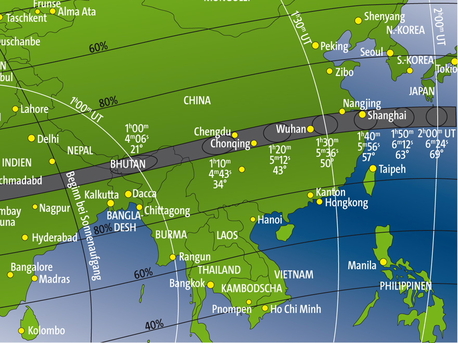Observation Highlight July
Black Sun over Asia
 © Kosmos Himmelsjahr
|
Total Solar Eclipse Progression
Live webcasts, pictures and reports of the eclipse can be found on the following websites:
The content is in English unless noted otherwise.
Webcasts
Amateur Astronomers Association Delhi (Indien - Varanasi & Sasaram)
Eclipse Chasers Athenaeum (Indien - Patna)
Chinese Astronomical Society (China, at least 8 different locations)
Atlaspost (China, site in Chinese)
Grupo Saros (China - Wuhan, site is in Spanish)
University of North Dakota (China - Wuhan)
Live! Eclipse 2009 (Japan, site is in Japanese)
Reports:
Website of Shelios 2009 (China - Huaying, site is in Spanish)
Astronomy.com (China - Wuhan)
Olivier Staiger (China - Shanghai)
Stephan Heinsius (China - Yangshan Island, site is in German)
If you know of any interesting blogs or tweeds please share them with us under isuggest@redshift-live.com
We will check them out and post them for everyone to see.
Redshift live
Observation Highlight July
Black Sun over Asia
 © Kosmos Himmelsjahr
|
Total Solar Eclipse Progression
Live webcasts, pictures and reports of the eclipse can be found on the following websites:
The content is in English unless noted otherwise.
Webcasts
Amateur Astronomers Association Delhi (Indien - Varanasi & Sasaram)
Eclipse Chasers Athenaeum (Indien - Patna)
Chinese Astronomical Society (China, at least 8 different locations)
Atlaspost (China, site in Chinese)
Grupo Saros (China - Wuhan, site is in Spanish)
University of North Dakota (China - Wuhan)
Live! Eclipse 2009 (Japan, site is in Japanese)
Reports:
Website of Shelios 2009 (China - Huaying, site is in Spanish)
Astronomy.com (China - Wuhan)
Olivier Staiger (China - Shanghai)
Stephan Heinsius (China - Yangshan Island, site is in German)
If you know of any interesting blogs or tweeds please share them with us under isuggest@redshift-live.com
We will check them out and post them for everyone to see.
Redshift live






